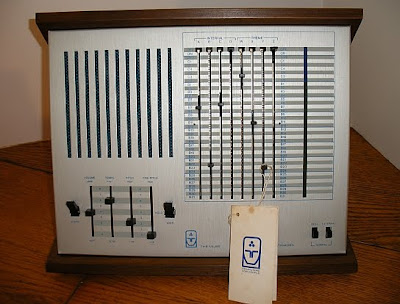via
this auction
"The Triadex Muse is the first digital musical composition instrument. It's a sequencer based tone synthesizer and it was first produced in 1972. It measures 10 inches high x 11 inches deep x 13-1/2 inches wide Essentially, the Muse is a deterministic algorithmic event generator that uses early digital integrated logic circuits to generate an audio output that produces a sequence of notes based on the settings of various parameters.
The front panel sliders, which control the melodies that are generated, allow for the possibility of 14 trillion musical note combinations. The included manual provides exact instructions. The musical computer is housed in a sleek mid-century modern wedge shaped finished wood and brushed aluminum case. The four small sliders in the lower-left control Volume, Tempo, Pitch, and Fine Pitch. The switches to either side of the sliders are used to start and stop the sequence, or to step through it note-by-note.
Of the eight larger sliders on the right, four control the musical intervals used (labeled A, B, C, and D), and four control the theme (labeled W, X, Y, and Z). There is also a "Rest" toggle switch at the lower right which acts as a "lowest note". Located at the upper left of the unit panel is the internal speaker. Additionally, the Muse can be slaved to that of another Muse, allowing for multi-part compositions.
In the 1970's when most synthesized music makers were huge and cost thousands, the Triadex Muse was a reasonably sized tabletop model and cost $300. Only a few hundred were produced and they were never made available in stores. The Muse was designed by two famed MIT professors, Marvin Minsky and Edward Fredkin. At the time, Minsky was moonlighting on the movie set of '2001 A Space Odyssey', teaching Stanley Kubrick about Artificial Intelligence as he created Hal.
Isaac Asimov described Minsky as one of only two people he would admit were more intelligent than he was, the other being Carl Sagan.
Ed Fredkin was an early pioneer of digital physics. In 1980, Carnegie Mellon U. created the Fredkin Prize, to be awarded to the creators of the first computer to win the World Chess Championship. The prize was paid out to IBM's Deep Blue in 1997 for beating world chess champion Gary Kasparov in the final game of a tied, six-game match. Deep Blue was a parallel supercomputer that processed an average of 200 million chess positions per second, and the first chess machine to draw and beat a world chess champion in a regulation game, and the first chess machine to beat the world champion in a regulation match. The cosmetic condition of this Muse is excellent as it's only been taken out for this demonstration. The original box, instruction manual, papers, & tags are included with the Muse
Muse Model: Muse-1
Serial no.: 00780-114
AC 115-125v 60CPS 40w
ok50Hz"
 "This auction is for an extremely rare Muse digital sequencer synthesizer made by the Triadex Corporation in 1972. The Muse was created by MIT professors Marvin Minsky and Edward Fredkin and is considered to be one of the first electronic musical instruments. The Muse uses a series of 14 sliders to control tempo, pitch, etc., and can create trillions of possible musical variations. This auction also includes a Triadex light show that links with The Muse . The Muse is extremely rare, less than 300 were believed to have been made, and only 50 of the light show! This unit is in very good working condition, the bottom wood panel of The Muse is warped and has a shrinkage crack. There is also some slight warping to the wood on the light show and a small crack. There is some light wear and few spots to the faceplate. The Muse and light show both appear to be in good working order, the sliders move smoothly, switches are good, and it sounds great."
"This auction is for an extremely rare Muse digital sequencer synthesizer made by the Triadex Corporation in 1972. The Muse was created by MIT professors Marvin Minsky and Edward Fredkin and is considered to be one of the first electronic musical instruments. The Muse uses a series of 14 sliders to control tempo, pitch, etc., and can create trillions of possible musical variations. This auction also includes a Triadex light show that links with The Muse . The Muse is extremely rare, less than 300 were believed to have been made, and only 50 of the light show! This unit is in very good working condition, the bottom wood panel of The Muse is warped and has a shrinkage crack. There is also some slight warping to the wood on the light show and a small crack. There is some light wear and few spots to the faceplate. The Muse and light show both appear to be in good working order, the sliders move smoothly, switches are good, and it sounds great."


























































